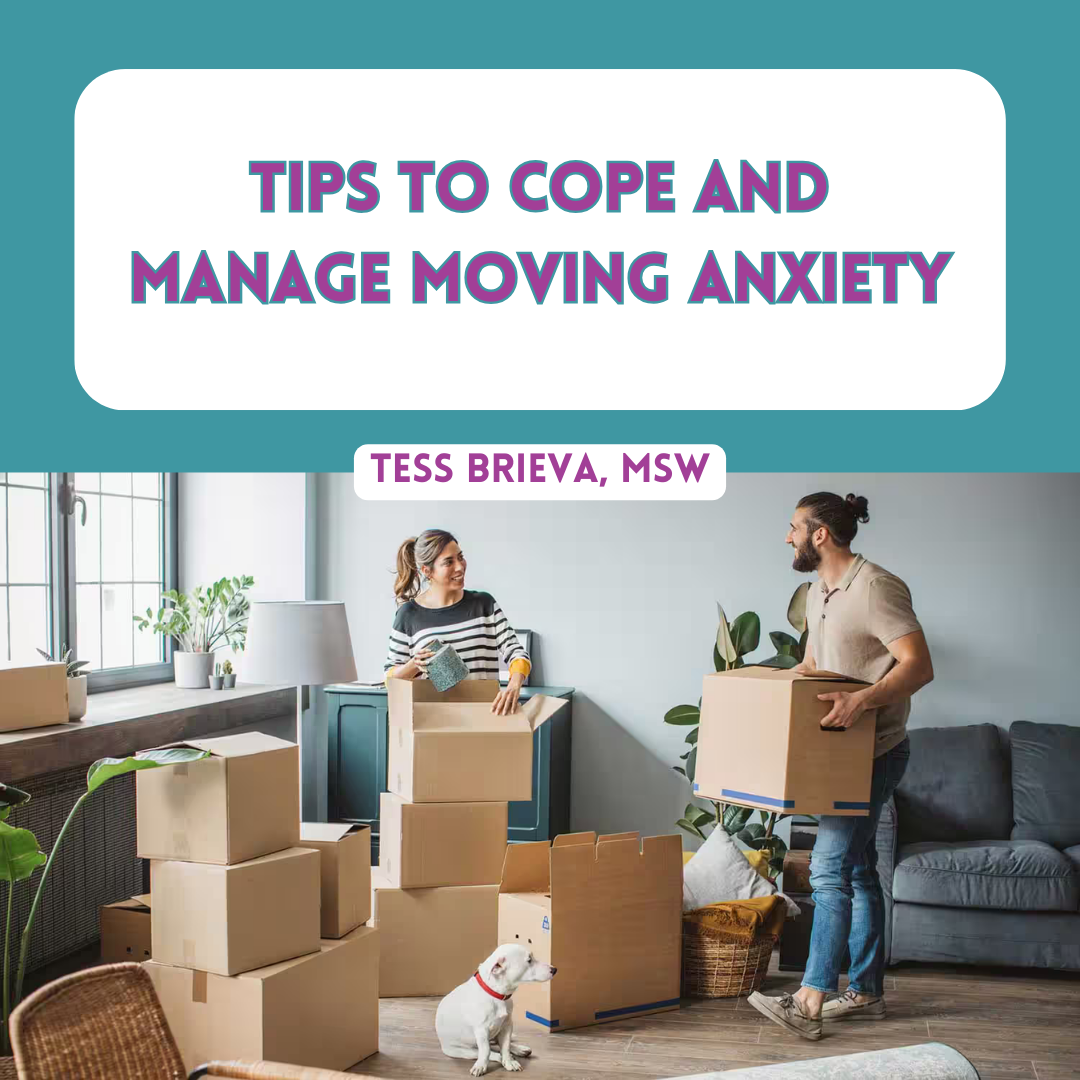13 Tips to Cope and Manage Moving Anxiety
By Tess Brieva, MSW
Moving… ah, one of life’s best known stressors. We all know that moving is challenging not only because of the logistics headache, but also because of the emotional toll associated with a change so tangible. Whether it’s due to job changes, proximity to loved ones, or lifestyle adjustments, it’s common to experience feelings of fear, sadness, and anxiety during this transition. The good news is that understanding how to cope with these emotions can help ease the process. This blog post aims to help you validate and accept your emotions, learn new cognitive interventions, and consider practical strategies to make this daunting transition more digestible.
Why is Moving So Stressful?
It is vital to honor and validate the stress response associated with moving. It is pretty much inevitable that moving will bring up an array of difficult feelings. For one, moving forces us out of our comfort zones, which can be intimidating. Furthermore, key stressors include financial expenses, logistical planning, and the challenge of managing time between work, family obligations, and packing. For families, the responsibility of addressing children’s emotions with compassion and patience is critical, yet adds another dimension of stress and difficulty to the situation.
Notably, moving isn’t just a logistical task; it intersects with various systemic barriers that disproportionately affect marginalized communities. Our society often fails to provide the necessary support for smooth transitions, whether it’s employers not offering paid time off, individuals with disabilities struggling to afford accessible accommodations, or people facing economic instability without resources for professional movers. These challenges highlight how factors like race, class, disability, and employment status compound the stress of relocation. For many, moving is not just about changing locations but navigating a landscape where structural inequities limit access to support. Recognizing these intersections helps us understand that moving anxiety is not just personal—it’s deeply tied to social systems that can make transitions even more isolating and difficult. This awareness is a call for greater compassion and advocacy for policies that provide equitable access to support, from affordable housing to adequate leave policies.
Moving – it’s a lot! Notice how you feel, emotionally and physically, when you truly recognize how stress-inducing moving often is. What is it like for you to validate and allow your feelings to be here?
Common Responses to Moving
When faced with an upcoming move, it’s natural to feel a range of emotions. You may feel one emotion strongly or a variety simultaneously:
Excitement and joy about this new chapter.
You might fear the unknown and wonder if the move is the right decision.
Financial concerns can heighten anxiety.
Sadness from leaving familiar people and places behind.
Worries about your family adjusting, particularly if you have children or older adults living with you.
Irritability and anger can increase due to the stress.
Moving can manifest in physical symptoms such as sleep disruption and joint pain.
Hyperfixation on preparation and worrying about small details.
Procrastination or executive dysfunction due to overwhelm.
Feeling alone or isolated in this change.
Did any of the above feelings resonate with your moving experience? Take note of what emotions you may have an easier time accepting, and which emotions you tend to push aside or shame. Building emotional awareness is one of the foundational steps to learning how to cope more effectively and sustainably.
Understanding Cognitive Techniques
Often, moving anxiety is amplified by cognitive distortions—thinking patterns that distort reality and lead us to expect the worst. These “thinking traps” might include catastrophizing (“Everything will go wrong”), black-and-white thinking (“If this move isn’t perfect, it’s a disaster”), or overgeneralizing based on past experiences (“I’ve always struggled with moves, so this one will be just as hard”). Recognizing these distortions is the first step toward managing them. By gently challenging these thoughts and offering more balanced perspectives, you can reduce the emotional intensity they create.
A helpful technique for managing moving stress is Cope Ahead, a skill drawn from Dialectical Behavior Therapy (DBT). This approach involves mentally rehearsing situations that may be stressful—like packing delays or homesickness—and preparing how you’ll respond. Cope Ahead encourages thoughtful planning, helping you feel more grounded even before the challenges arise. For example, if you worry about feeling isolated in your new neighborhood, you might plan ways to meet new people, like joining a local class or community group. By identifying potential obstacles and practicing coping strategies in advance, you’re building resilience and reducing the power of anxiety when moving day comes.
Practical Strategies to Reduce Moving Anxiety
Below are concrete strategies to support you in your move. Notice which ones resonate with you, and which ones don’t really match your needs. Get creative and draw specific elements from the suggestions. Remember, this is your move, you get to decide how to best prepare for it.
#1, Ask for Help
This is the perfect opportunity to lean into your community of loved ones. Asking for help doesn’t have to only include the packing or the moving – you can ask for help with deep cleaning, organizing your next place, child support, or simply their presence (i.e., body doubling) to help with focus. If you are able, you may consider hiring professional movers. Overall, sharing the load can make the process feel much less overwhelming.
#2, Start Small
Start planning as soon as you can. However, notice how much pressure you may be putting on yourself – observing the amount of thoughts that include “should” or “supposed to” can increase awareness. What would it be like to start really small? Can you commit to 15 minutes this weekend to tackle one task? This could include buying packing tape, assembling some moving boxes, or texting friends to ask for help in advance.
#3, First, Get Rid of Stuff
Before you get fixated on packing and organizing, start by clearing your space out as much as possible. Focus on one area at a time, throwing away expired foods, donating clothes, and letting go of decorations that no longer fit who you are.
#4, Don’t Underestimate the Power of a List
Lists are possibly the most basic suggestion for moving, but they are popular for a reason! You can create a list to generally prioritize tasks, write the timeline of your move, or write down some barriers to address. This will not only make the moving process smoother, but can alleviate some anxiety through seeing that the problem is not as impossible as it feels.
#5, Be Mindful and Compassionate Towards Procrastination
Be mindful that procrastination often serves as a coping mechanism for overwhelm, not a sign of laziness or failure. Instead of judging yourself, approach it with compassion by acknowledging the underlying stress and gently refocusing when you're ready. Trust that this will work out, especially when you connect to your support system.
#6, It Doesn’t Have to be Perfect
You do not need to pack perfectly. It’s okay if garbage bags are storing your clothes, if t-shirts are protecting your glassware, and if spices and holiday decorations are in the same box. Overall, go easy on yourself – usually you will have more time after you’ve moved to organize your new space.
#7, Take Breaks
Protect your mental health during this stressful time. Try to incorporate ample breaks into your schedule. Recognize what your limits might be for packing in a day. Drink water and eat enough. See friends and try to get a couple laughs in. Buy yourself a nice treat. Sleep and rest as much as you can. It’s okay to do less in a day than you wanted to – Rest up and get back to it when you have more capacity. These ideas will help prevent an emotional breakdown or burnout from occurring.
#8, Choose One Space for Boxes
Utilize one space in your current home to store boxes and items ready to move. Aim to keep this area tidy and as compact as possible. Trying to keep all other spaces as normal as possible can reduce your level of stress and perceived chaos.
#9, Prepare a Comfort Box
Pack an essentials box filled with comfort items and necessities. Having access to familiar items can provide reassurance during the chaos of moving.
#10, Grounding in Intention
The stress of moving can lead us to lose sight of the end goal – to start a new chapter. Remind yourself of what you are looking forward to after this move. It might be a new space, more financial flexibility, being closer to loved ones, or something else. Try to stay connected to this hope as you get through this difficult period.
#11, Consider Therapy
Depending on the context of your move or your mental health history, you may find that your anxiety is entirely consuming. You may find that leaning on friends and trying different coping strategies is not enough. In this case, you may benefit from meeting with a therapist or joining a support group. Remember, you don’t need to go through this alone.
#12, Helping Children Adjust
When moving with children, it’s important to break the news gently. Involve them as much as you can in the decision-making process. Take some time to pack a box together with their favorite items for easy access. Prioritizing setting up their bedroom first can increase comfort and stability in the new environment.
#13, Post-Move Anxiety
It’s normal for moving anxiety to linger even after the move is complete. Begin making your space feel like yours – incorporate familiar items and set up your favorite areas right away. Hosting a housewarming gathering or inviting a close friend over for dinner can help you feel more settled.
Conclusion
In conclusion, moving anxiety is a common experience that many people face, but implementing thoughtful coping strategies can make the transition feel more manageable. Moving is a significant life event, often filled with both excitement and uncertainty, so it’s important to embrace the process with patience and flexibility. Remember, you don’t have to do it all alone—whether it’s asking for emotional support from friends, seeking professional guidance, or accessing community resources. Each step forward, no matter how small, is progress, and giving yourself grace along the way makes the journey more sustainable and empowering.


